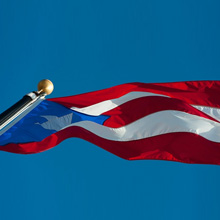When Luis Fortuño became governor of Puerto Rico in January 2009, the U.S. commonwealth's credit rating was near “junk bond” level. Puerto Rico’s budget deficit stood at $3.3 billion — nearly 44% of revenues – in large measure because almost 70% of its budget was devoted to government employee salaries and benefits. By 2011, its budget deficit had been reduced to less than 11% of its revenues, and government job rolls had been slashed. Defined benefit pension plans were closed out, and the overall budget was cut by a full 20%. Puerto Rico’s bond rating with Moody’s jumped from Baa3 to A3 — its highest in 35 years. Fueled by the island’s fiscal turnaround, rumors even began to surface Republican presidential candidate Mitt Romney might offer Fortuño a spot on the ticket as the vice-presidential candidate, in order to attract the Hispanic vote.
Critics argue, however, that Puerto Rico’s recent fiscal turnaround has not addressed the long-term structural challenges that confront the commonwealth, casting a dark cloud over the island’s prospects. Puerto Rico’s per capita income of $16,300 in 2010 was the highest in all of Latin America — just slightly higher than that of Chile and Uruguay — and only 10% lower than that of Mississippi, the poorest U.S. state.Fifty-five of the Fortune 100 companies and 178 of the Fortune 500 companies operate in Puerto Rico.But the island’s unemployment rate of 14.8% and its poverty rate of 45% are higher than those of any U.S. state. Just as troubling, Puerto Rico’s per capita income in 2010 ($16,300) was about 10% lower than in 2008 ($18,100).
“The transformation of Puerto Rico from 1970 until 2000 was phenomenal,” notes Wharton management professor Mauro Guillén. “Puerto Rico needs to move up into higher-value manufacturing and services,” rather than rest on the laurels of its earlier success, largely in the pharmaceutical sector. Although Puerto Rico has a large number of educated bilingual workers, Puerto Rican wages are high for Latin America, and the island now has to compete with emerging Latin American countries that have recently forged free-trade pacts with the U.S. “Puerto Rico is developed, but it is very vulnerable,” says Guillén. A key question facing multinational companies: “What would you make in Puerto that you would not make anywhere else?”
“Puerto Rico is a sleeping giant in the Caribbean Basin,” argued Rafael Saldaña, chief executive of Banesco USA bank, at the "Puerto Rico Conference 2012: Revitalizing Innovation" conference held recently in San Juan, sponsored by the Puerto Rico Chamber of Commerce. However, he added, Puerto Rico needs “to look South and West,” not just look North – that is, towards the mainland U.S. – as has too often been its custom.
A Bold Plan
Until it was gradually phased out by 2006, the Puerto Rican economy depended heavily on Section 936 of the IRS Code which provided U.S. firms operating in Puerto Rico with tax-free income.“It was a win-win for everyone,” says David Lewis, vice-president of Manchester Trade, a trade consultancy based in Washington, D.C. “All of the billions of dollars stayed in Puerto Rico, and the banks lent out the profits.” The boom that resulted was fueled by “readily available, cheap capital,” adds Lewis, a former Assistant Secretary of State of Puerto Rico. “Puerto Rico has been an important hub, in particular, for big pharmaceutical firms like Pfizer, which have kept many of their investments on the island even after ‘936’ was gradually ended. Although only a limited amount of research and development have been done in Puerto Rico, their plants were much more important than mere ‘maquila’ plants” in such countries as Mexico, which are normally restricted to low-wage lower-value assembly.
Nevertheless, it gradually became clear after the expiration of "936" that “new companies were not coming in [to Puerto Rico] at the same pace as they had been coming before,” notes Lewis. Meanwhile, “Labor-intensive non-high-tech component plans were no longer competitive in Puerto Rico” not just because of the expiration of the 936 provision, but also because of changes in the global economy. Too many countries in Latin America were opening their own assembly plants to multinationals, with workforces prepared to do the job far more cheaply. Puerto Rican wages were rising too high to remain competitive in labor-intensive sectors, like apparel. “All of a sudden, Puerto Rico was no longer competitive in areas where 75% to 80% of your expenses come from payroll costs,” says Lewis, who advises U.S. companies on where to locate Latin American operations.
How to respond? Last fall, Pedro Pierluisi, Puerto Rico’s Resident Commissioner to the U.S. Congress, presented the Puerto Rico Investment Promotion Act (PRIPA) of 2011 (H.R. 3020). Section 933A of that bill would authorize, but not require, Puerto Rico corporations that earn at least 50% of their income on the island to choose to become domestic U.S. companies. In doing so, those companies would essentially receive the same favorable federal tax treatment that Puerto Rican individuals receive under current law — making it cheaper for companies to expand their operations and create new jobs on the island. PRIPA has received bipartisan support among a wide range of Puerto Rican leaders in government and business. “The approval of Section 933A — proposed last year by a multi-sector contingent of public, private and labor sector representatives — is key to Puerto Rico’s economic development,” says William Riefkohl, executive vice president of the Puerto Rico Manufacturers Association (PRMA). “All of the sectors we represent are deeply concerned with the sober outlook for the economy of Puerto Rico, so we are joining forces to support this common goal.”
Would Section 933A of PRIPA really wind up making Puerto Rico a lot more competitive? Eugenio Alemán, senior economist at Wells Fargo Securities, argues that Section 933A would not do a great deal to expand job rolls in Puerto Rico because much more fundamental challenges confront investors on the island. “Many of the institutional settings in the Puerto Rican economy discourage investments in the island, compared to other countries in the region that have free access to the market,” he says.
Alemán notes that although the gradual phasing out of the earlier 936 helped “push the Puerto Rican economy off the cliff,” Puerto Rico “had been walking close to that cliff for a long time” before 936 was ended. And once the 936 tax exemptions expired, notes Alemán, “the only advantage Puerto Rico had left was its access to the U.S. market.” But that advantage was gradually disappearing in the years following the implementation of the 1994 North American Free Trade Agreement (NAFTA), and subsequent free-trade agreements that the U.S. signed with South and Central American countries – such as the Central American Free Trade Agreement (fully enacted by 2009) and U.S. bilateral agreements with Chile (2004), Peru (2009) and Colombia (2011). These pacts gave exporters from those countries the same duty-free access to the North American market as Puerto Rican exporters had enjoyed for years.
This transition to the ‘new reality,’ adds Alemán, was worsened by the U.S. decision in 2000 to grant China Permanent Normal Trade Relations (PNTR), which paved the way for China to join the World Trade Organization in December 2000. As a result of all these changes, “Puerto Rico had to compete not only with the other 50 U.S. states but also with countries that now had equal access into the U.S. market,” says Alemán. Ultimately, when the U.S. government eliminated the 936 benefit, Puerto Rico's privileged position “disappeared fast and furiously.” Gradually, “many industries left the island for betterpastures, with the exception of the pharmaceutical and some electronic goods manufacturing,” adds Alemán.
In any case, it is doubtful whether PRIPA will win approval from the U.S. Congress. “The mood in Congress is for cutbacks,” says Lewis. “Not for more tax benefits; certainly not for big corporations” that would benefit from PRIPA. So far, PRIPA has gotten “no real traction in Congress,” he adds. For his part, Guillén says that if the U.S. Congress does manage to authorize new tax benefits that encourage multinationals to invest more heavily in Puerto Rico, “I can’t imagine that it will be anything as generous as what was put in place” in earlier decades.
Bringing People to the Banks
Another challenge for the Puerto Rican economy is the weakness of its banking system. According to Aurelio Alemán, president and CEO of First BanCorp (Puerto Rico), “Puerto Rico’s financial landscape has changed as a result of the prolonged recession.” The island’s banking system has deleveraged, with total assets decreasing by 30% from 2005 through 2011, and gross loans decreasing by 16% over that period. On the other hand, “during 2011-2012, the industry has stabilized and has started to balance risks and return to profitability,” according to Alemán. While the local financial industry is “gradually recovering,” to achieve full recovery, the remaining “non-performing assets need to be eradicated from the system,” he adds.
Meanwhile, Puerto Rican banks are also hoping to expand their economic role by bringing more and more ordinary Puerto Ricans into the formal banking system – a process known in Spanish as raising the rate of ‘bancarización.’ “Although it may seem that we are doing well versus the banking system in Latin America, against the U.S. we turn out to look weak,” notes Javier Hidalgo, president and CEO of Santander Puerto Rico, the local division of the Spanish banking giant. About one-third of Puerto Rico’s four million people are not even involved in the country’s formal banking system. Elsewhere in U.S. territory (the U.S. minus Puerto Rico), a mere 7.7% of the total population operate their financial lives outside the banking system.
Other indicators from its banking industry place Puerto Rico in the middle ranks of Latin American economies. In Puerto Rico, domestic credit as a percentage of GDP was an estimated 74% in 2011, a much higher figure than the 29% recorded in Argentina, 45% recorded in Mexico and 66% recorded in Colombia. Meanwhile, in Chile and Brazil, domestic credit as a percentage of GDP amounted, respectively, to 90% and 98% of GDP — much higher figures than in Puerto Rico. Puerto Rico also lags behind Brazil and Chile when it comes to the availability of Automatic Teller Machines. In 2011, there were only 3.1 ATMs per 10,000 inhabitants in Puerto Rico, compared with 3.6 ATMs in Colombia, 4.8 ATMs in Chile, and 9.2 ATMs in Brazil. Once again, Puerto Rico ranked considerably higher than Mexico, where there were only 2.9 ATMs per 10,000 inhabitants, and higher than Argentina, which had only 1.9 ATMs.
Santander Puerto Rico and other banks on the island hope to introduce large numbers of new customers to the banking system in an effort to promote “social inclusion” and speed up economic growth, says Hidalgo. “Countries where households have more access to financial services tend to have a higher per capita income,” he argues.
Unfortunately, as much as 30% of Puerto Rico’s economic activity takes place in the "underground economy," bankers and economists agree, so expanding the usage of formal banking institutions could promote economic development by discouraging black market activity. As the Bloomberg View columnists in Puerto Rico wrote collectively recently, “To fight money laundering and promote development, the island’s government should do more to encourage its residents to use banks.” At a time when one-third of Puerto Rico’s population does not use formal banks, “their cash-only transactions help to enable the island’s burgeoning black economy,” they added.
An Identity Problem
According to Paul Osterman, MIT professor of human resources and management, and co-director at the MIT Sloan Institute for Work and Employment Research, the percentage of Puerto Ricans aged 25 through 34 who have some college education — about 25% – is slightly higher than that in the poorest U.S. states, while the percentage of college graduates in Puerto Rico is almost as high as in the U.S. as a whole. Yet the average annual earnings of Puerto Ricans between those ages lag behind the earnings of their counterparts in the poorest U.S. states, both among high school graduates and college graduates. Lower down the skills ladder, notes Osterman, there is a shortage of basic skills among workers who do not wind up attending college. “The average Puerto Rican answer score for eighth-grade math in the National Assessment of Educational Progress is half that of the U.S. States,” Osterman notes. Banesco’s Saldaña agrees that Puerto Rico has talent “in abundance,” but that the island needs to leverage its base of skills more effectively.
“They need to create conditions in which they can use the only resource they have – their people,” adds Guillén. Too many of the “very educated ones leave for the mainland” because of the lack of job opportunities at home. Puerto Rico is too dependent on the U.S. market for agriculture, chemicals, pharmaceuticals and services, notes Guillén. The island’s splendid beaches have made it major attraction for U.S. travelers during the winter, but the Puerto Rican tourism industry has “failed to attract European tourists,” who often prefer such destinations as nearby Dominican Republic, which is “much cheaper,” he notes. Although the hotel sector employs some 60,000 people, “there is tough competition” from the rest of the Caribbean region, he adds, and things could get worse if Cuba opens up to U.S. travelers.
Lewis argues that Puerto Rico’s leadership needs to devise more imaginative solutions. Although there is a local consensus that PRIPA represents the results of "thinking outside the box," Lewis argues that “[PRIPA] is not outside the box enough. We need a radical turnaround that would involve more services, not just manufacturing.” Puerto Rico also needs to be more assertive about promoting its interests around the world. States like Massachusetts and Michigan operate dozens of offices that promote trade and investment around the globe, but Puerto Rico has only six, including no offices at all in Asia. “We [Puerto Ricans] need five offices in Asia,” says Lewis.
When all is said and done, Puerto Rico's most formidable challenge may be that it has no clear role model to follow on its long road to full-fledged economic development. There is no place else quite like Puerto Rico, with its unique combination of Latin American and North American cultures and political institutions. “We were really slow and complacent, because we were the only ones who had the U.S. dollar and the U.S. flag and the customs union with the U.S.,” Lewis says. “Now, everyone else has the U.S. dollar, too, and as for the U.S. flag – that’s not important now” in world where corporations extend their reach easily across borders.



